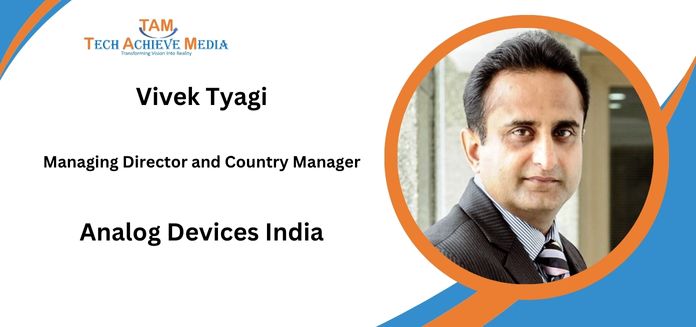As India’s demand for reliable, high-speed internet surges, Analog Devices India (ADI) is positioning itself at the forefront of telecom innovation. Speaking at a media briefing held at the India Mobile Congress 2025, Vivek Tyagi, Managing Director and Country Manager of Analog Devices India, detailed how the company’s cutting-edge millimeter wave (mmWave) technology could redefine broadband access thus bringing fiber-like connectivity without the need for digging roads or laying cables.
Also read: Automotive Displays – Basics of TFT LCD, OLED, and Micro-LED Displays
How Analog Devices Contributes to India’s Indigenous Telecom Ecosystem?
Analog Devices has been actively partnering with India’s telecom ecosystem to enable indigenous solutions. The company collaborated with the Tejas Network, part of the Indigenous Telecom Equipment Project, which powered BSNL’s large-scale 4G rollout.
Also read: Automotive Displays Part 2 – Power Techniques of TFT LCD, OLED, and Micro-LED Displays
“We collaborated with the Tejas Network, which developed the Indigenous 4G technology deployed by BSNL. We were a partner to BSNL in that initiative,” said Vivek Tyagi. “This has happened in the past and will continue to happen in the future.” While ADI serves multiple industries, industrial, automotive, and communications, Tyagi emphasized that telecom remains a critical focus area, especially as India transitions toward next-generation broadband.
Biggest Challenge in Achieving True Broadband Connectivity in India
India has over a billion mobile internet users, yet the country still struggles to deliver true broadband speeds of 100 Mbps or more to homes. The reason, according to Tyagi, lies not in technology but in deployment barriers. “It’s not easy to get permissions from all municipal bodies to dig roads and lay optical fiber,” he explained. “Many apartment complexes deny access, and if you walk through any Indian city, you’ll see hanging wires everywhere. These issues are slowing down the rollout of broadband.” To solve this, the government had auctioned the FR2 spectrum (26–27 GHz), a high-frequency band suitable for wireless fiber-like broadband, which ADI is now helping operators tap into.
How Millimeter Wave Technology Solves these Challenges
Millimeter wave (mmWave) technology allows broadband signals to be transmitted wirelessly at high frequencies from existing telecom towers to nearby apartment complexes. “You use the tower infrastructure already available in cities,” said Tyagi. “You beam the 26–27 GHz spectrum toward apartment complexes, where a small receiver tower picks it up. From there, Ethernet cables can connect to 8–10 homes, delivering 100–200 Mbps instantly.”
This eliminates the need for digging roads or seeking permissions, enabling faster and more scalable broadband access. Telecom operators like Reliance Jio (Air Fiber) and Airtel (Xstream Fiber) are already experimenting with similar models. “In this 26–27 GHz spectrum, Analog Devices provides a complete lineup of RF chips and our own RF reference line. This is our key focus area for the coming years,” Tyagi said. “We believe this technology can help achieve the dream of 100 million connected broadband homes.”
Benefits of Millimeter Wave Broadband for Consumers and Operators
Tyagi said that broadband is now as essential as food, clothing, and shelter. “In India, we used to say roti, kapda, makaan (food, clothing, and shelter),” he remarked. “Now there’s a fourth essential, which is Internet connectivity. When people move into new homes, the first thing they ask for is broadband. This technology ensures instant connectivity.”
For consumers, the benefit is quick, high-speed access without the long wait for cable installation. For telecom operators, it means faster revenue realization and higher Average Revenue Per User (ARPU) compared to mobile users. “India has over 1.2 billion cell phone users, but ARPU is only about $2.5, which is among the lowest globally,” Tyagi said. “Broadband subscribers generate much higher revenue, and telcos can increase it further by bundling digital content and services.”
Challenges in Deploying Millimeter Wave Technology across India
While mmWave sidesteps many of the logistical hurdles of fiber deployment, its performance must be validated across India’s diverse terrains. “India’s geography ranges from Kashmir to Kanyakumari, which includes urban, rural, coastal, and hilly terrains. Telcos need to test and fine-tune this technology for these varied conditions,” Tyagi noted. “But even then, it’s far simpler than laying fiber.”
He added that the current “Air Fiber” deployments in India are based on unlicensed sub-6 GHz bands, suitable for limited-scale rollouts. “The next phase will happen in the licensed FR2 band, which can scale to tens of millions of users,” Tyagi said. “That’s when we’ll see mass adoption.”
Where this Technology been Deployed So Far
When asked about real-world implementation, Tyagi revealed that the technology has been tested abroad, but India is likely to be its first large-scale deployment ground. “In very limited volumes, this technology has been tested in the US in some use cases,” he said. “But there hasn’t been a large-scale deployment yet anywhere in the world. In the US and Europe, housing is more spread out, and this technology works best in dense urban areas with high-rise apartments.”
That makes India a prime candidate for scaling the technology. “We are choosing India because the demand is very strong, and telecom operators are expressing the need for it, especially in cities like Noida, Pune, and Bangalore,” Tyagi added. “In such dense areas, laying optical fiber is extremely difficult, so this wireless solution is ideal.”
What this Means for Existing Wired Fiber Networks
Tyagi was quick to note that millimeter wave will complement rather than replace wired fiber networks. He clarified that both fiber and mmWave will coexist: “For spread-out independent houses, optical fiber remains the best solution. But for dense urban populations, millimeter wave offers a faster, more practical alternative.”Whatever is already laid will continue as it is because fiber provides a very stable and flawless connection,” he said. “Millimeter wave is meant for rapid deployment and expansion where fiber rollout is constrained.”
He also pointed out the recurring issue of fiber cuts in existing networks: “Many users experience outages when underground cables are damaged during construction or roadwork. With wireless broadband, that problem disappears entirely,” he noted.
He added: “Our focus for the next three to five years is to make this technology succeed at scale,” Tyagi concluded. “If we do this right, we can truly achieve the vision of connecting 100 million Indian homes with high-speed broadband.”









